The Australian Church
Flinders Street, Melbourne
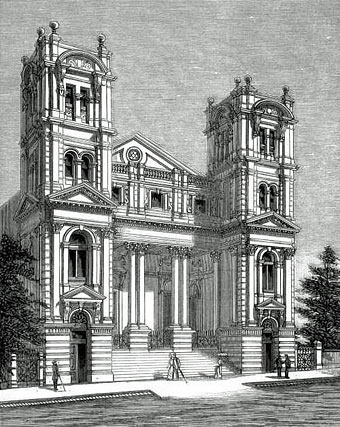
The Australian Church exterior
(Australasian Sketcher 27 January 1887)
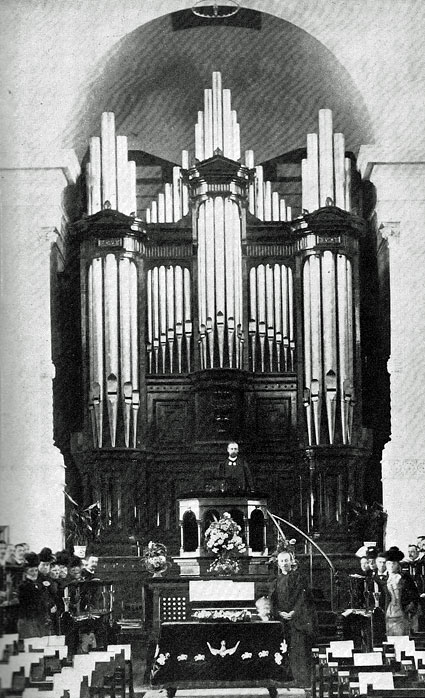
The Australian Church interior
(C.R. Badger, supplied to W.G.S. Smith)
The Australian Church was founded by The Revd Dr Charles Strong (1844-1942), who had resigned as Minister of The Scot’s Church, Melbourne, after a major disagreement. Services began in 1885 in the Temperance Hall, Russell Street and later in the Atheneum Hall, Collins Street.
The foundation stone was laid on 19 March 1887 for a large new church seating 1,200, in the classical style, with twin towers; this was erected at the eastern end of Flinders Street, very close to Spring Street. The building, which was first used for services on 4 December 1887, was designed by the architect William Salway, who had a flourishing practice in Melbourne in the late 19th century: he had arrived in Victoria in 1854 and served articles with Joseph Reed. He had toured Asia, worked in China in 1868-75, and returned to Melbourne in 1876, where he trained such architects as Harold Desbrowe Annear.
George Fincham submitted a specification for a three-manual organ in April 1887, but this was deferred. In November 1887 he installed a two manual organ of 13 speaking stops, eight couplers and tubular-pneumatic action that was placed in the church until late 1889 when it was sold to St John’s Anglican Church, East Malvern. Fincham had imported this instrument from his friend and former colleague Alfred Hunter as a model for building organs with tubular-pneumatic action.
| GREAT ORGAN Violin Diapason Hohl Flöte Dulciana Flute d’Amour Flautina Great Sub Swell to Great Sub Swell to Great Unison Swell to Great Octave SWELL ORGAN Geigen Principal Lieblich Gedact Gamba Voix Celeste Flauto Traverso Oboe Sub Octave Octave Tremulant PEDAL ORGAN Bourdon Violoncello Great to Pedal Swell to Pedal |
8 8 8 4 2 8 8 8 8 4 8 16 8 |
TC |
Compass: 61/30
Spotted metal pipework above 4 feet
Quotations for a large organ were sought from Hill & Son, London, and from Fincham & Hobday, Richmond. Hill & Son quoted on 3 May 1888 to build the following instrument at a cost of £1,200 (estimate number 4426) this was not accepted.
| GREAT ORGAN Double Open Diapason Open Diapason Open Diapason Clarabella Principal Harmonic Flute Twelfth Fifteenth Mixture Posaune Clarion SWELL ORGAN Boudon Open Diapason Stopped Diapason Salicional Voix Celeste Principal Fifteenth Mixture Horn Oboe SOLO ORGAN Viol di Gamba Lieblich Gedact Dulciana Suabe Flute Corno di Bassetto Vox Humana PEDAL ORGAN Open Diapason Bourdon Quint Violoncello Posaune |
16 8 8 8 4 4 2-2/3 2 IV 8 4 16 8 8 8 8 4 2 IV 8 8 8 8 8 4 8 8 16 16 10-2/3 8 16 |
TC (reeds in box) |
5 ordinary couplers & Sw-Gt 8ve & Sub 8ve
7 composition pedals
Pneumatic [Barker lever] to Great
Tubular action for Pedal & drawstops
Spotted [metal] to 4ft
2 separate feeders
Case
Packed f.o.b.
Engines £50 extra
Fincham & Hobday was finally engaged to build a new four-manual organ of 53 speaking stops, 13 couplers and tubular-pneumatic action, with detached console. This was the largest church organ in 19th century Australasia and the second largest organ built by the Fincham firm, after its instrument for the Melbourne Exhibition of 1880. The final cost was £2,116. The organ was opened in August 1890 by W.E. Nott. The elaborate carved casework was designed by William Salway and constructed in Tasmanian blackwood by Mr Bell; he may have been George N. Bell whose premises were located at the time at 64 Lennox Street, Richmond..
The firm was pressed for space in the construction of this instrument and built in 1889 the surviving brick factory building in Stawell Street, Richmond so that it could be erected and tested before being moved to the church. Following its erection at the church, serious problems with the action developed in May 1891 owing to dampness: the church was located on the side of a hill and clearly the excavations on the west had not been properly sealed to prevent moisture penetration.
The tonal design of the instrument was remarkably progressive for the time, with its Great and Swell choruses complete to five-rank Mixture, the variety of tapered stops – Gamba (Great). Gemshorn and Harmonic Gemshorn (Choir), Spitz Flöte (solo), the orchestrally-conceived fourth manual with a wide variety of imitative reeds, and the generous Pedal Organ with 32ft Double Open Diapason of wood. The scales of the Flute Octaviante and Gemshorn Harmonic were based upon comparable stops in the Hill & Son organ at Melbourne Town Hall.
| GREAT ORGAN Double Open Diapason Open Diapason Open Diapason Claribel Gamba Octave Flute Harmonic Wald Flute Fifteenth Mixture Tromba Clarion Swell to Great Sub Swell to Great Swell to Great Super Choir to Great Solo to Great SWELL ORGAN Bourdon Open Diapason Violin Diapason Lieblich Gedact Keraulophon Principal Suabe Flute Fifteenth Sesquialtera Contra Fagotto Horn Oboe Clarion Swell Sub Octave Swell Super Octave CHOIR ORGAN Salicional Lieblich Gedact Dulciana Gemshorn Gedact Flute Gemshorn Harmonic Clarionet Swell to Choir Solo to Choir SOLO ORGAN Lieblich Bourdon Spitz Flöte Flute Harmonic Gamba Voix Celeste Flute Octaviante Clear Flute Piccolo Harmonic Bassoon Orchestral Clarionette Orchestral Oboe Cor Anglais Vox Humana Tremulant PEDAL ORGAN Double Open Diapason Open Diapason Violon Bourdon Octave Bass Flute Trombone Trumpet Clarion Great to Pedal Swell to Pedal Choir to Pedal Solo to Pedal |
16 8 8 8 8 4 4 4 2 V 8 4 16 8 8 8 8 4 4 2 V 16 8 8 4 8 8 8 4 4 2 8 16 8 8 8 8 4 4 2 16 8 8 8 8 32 16 16 16 8 8 16 8 4 |
large small (unenclosed) (enclosed) TC TC wood wood wood |
Compass: 58/30
Wind pressures: Great, Swell & Solo Organs 3 inches; Choir Organ 2-7/8 inches, Pedal Organ 5-1/2 inches
4 pneumatic pistons to Great
4 pneumatic pistons to Swell
3 pneumatic pistons to Choir
6 pneumatic pistons to Solo
Total number of pipes: 3,272
With declining membership, the church moved to a smaller building at 19 Russsell Street, adjacent to the State Theatre. This building was refurbished by architect D.R. Dossetor; it was built from reinforced concrete. The organ was re-erected here in 1922 by George Fincham & Sons for the opening of the building on 18 June 1922. Here the organ was located in a far smaller internal space and failed to sound to advantage. A new four-manual stopkey console was installed in 1926 at a cost of £220 but the 1890 specification remained unaltered.
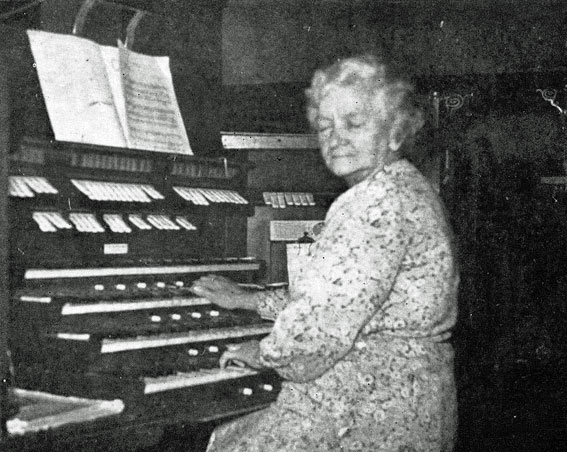
Louise Dean at the 1926 console
(Louise Dean, Heidelberg Musicians Past and Present.
Heidelberg: Heidelberg Historcial Society, 1969) p.15
The Australian Church was dissolved in February 1957. The organ was moved to Wilson Hall, within the University of Melbourne. Here it was rebuilt by George Fincham & Sons Pty Ltd to an innovative tonal scheme that was clearly influenced by the firm’s voicer Stephen Laurie, who had previously worked with the John Compton Organ Company Ltd in London; it was opened by Fernando Germani in 1956. The majority of the Fincham & Hobday pipework was retained, however it was not possible to accommodate the 32 foot Double Open Diapason in the new location. Sadly this instrument fails to sound to advantage in its present home owing to an unsatisfactory location within a copper-lined chamber and poor provision for tonal egress. The hall has a very non-resonant acoustic unsuited to musical performance.
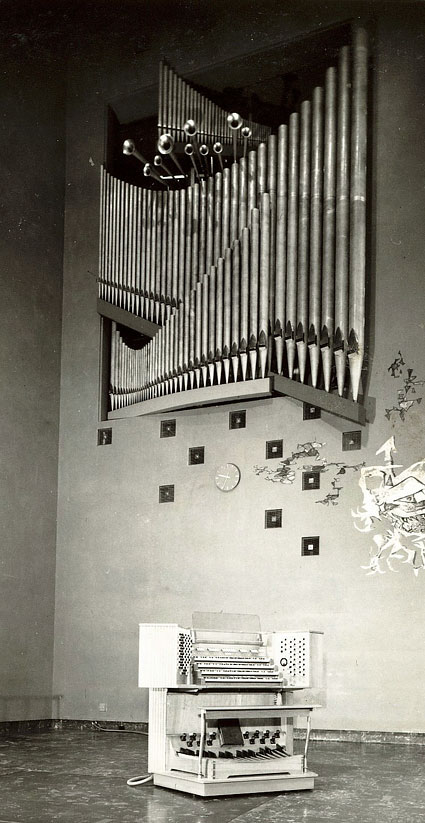
Wilson Hall, University of Melbourne
(George Fincham & Sons Pty Ltd)
The splendid blackwood case of the 1890 organ was utilised by George Fincham & Sons Pty Ltd for the rebuilding and enlargement in 1958 of the William Anderson organ in Sacred Heart Catholic Church, Rathdowne Street, Carlton, where it may still be seen.
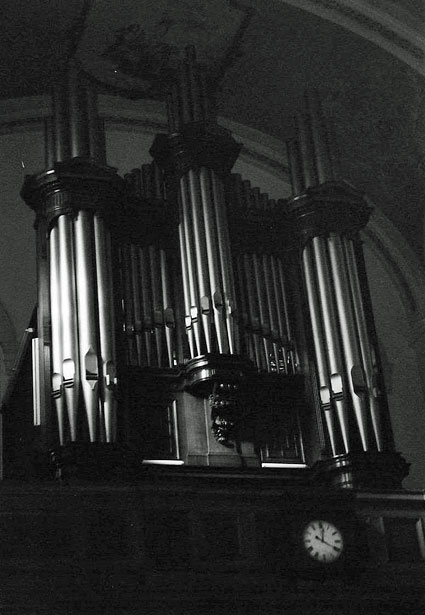
Sacred Heart Catholic Church, Carlton (John Maidment)
The Australian Church building in Flinders Street was modified and used by Cheneys as a motor car salesroom. It was demolished in the 1980s for the erection of the new Shell building, at the corner of Flinders and Springs Streets, designed by Harry Seidler and opened in 1988.
John Maidment
July 2008
C.R. Badger, The Reverend Charles Strong and the Australian Church. Melbourne: Abacada Press, 1971
Australian Dictionary of Biography online: http://www.adb.online.anu.edu.au/biogs/A070080b.htm
E.N. Matthews, Colonial Organs and Organbuilders. Carlton: Melbourne University Press, 1969, pp.107-8.
Hunter specification noted John Maidment (at East Malvern) 1963
Australian Church specification noted by Enid Matthews from the records of Fincham & Hobday (specification 14/69 25 September 1888) and also recorded in George Fincham & Sons correspondence 8 June 1921
Hill & Son estimate book, specification sourced by Geoffrey Cox (records held at British Organ Archive, Birmingham Central Library)
Kevin Fahy, Christina Simpson, Andrew Simpson, Nineteenth Century Australian Furniture. Sydney: David Ell Press, 1985.